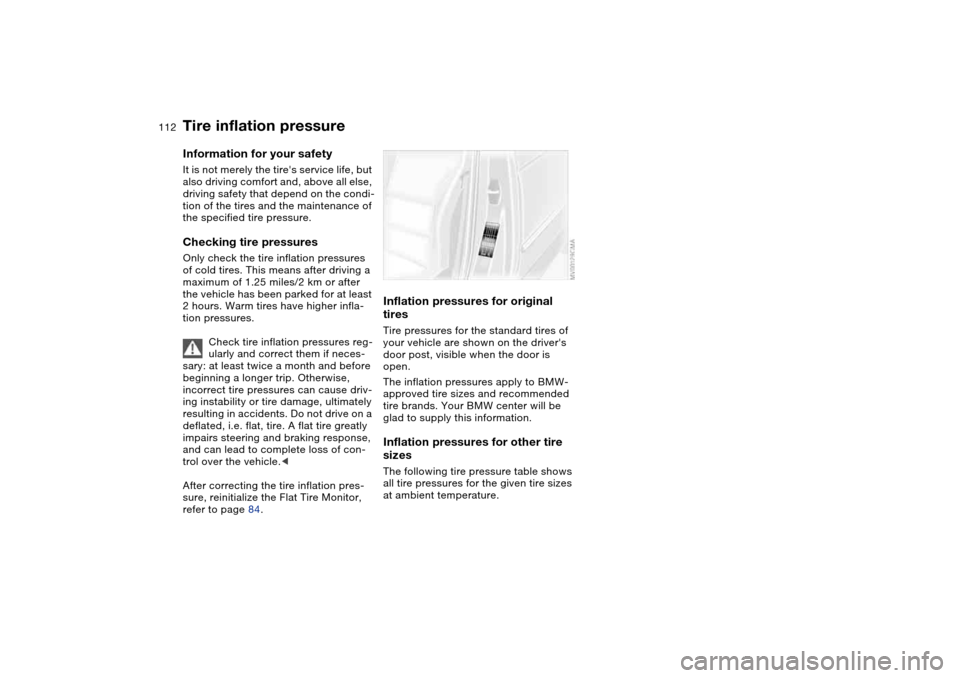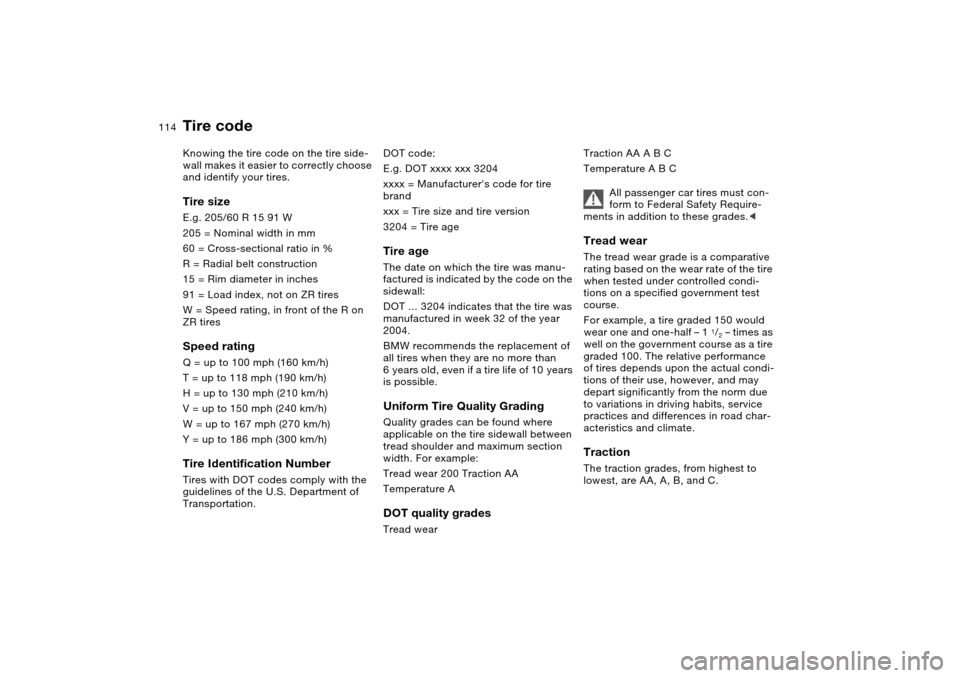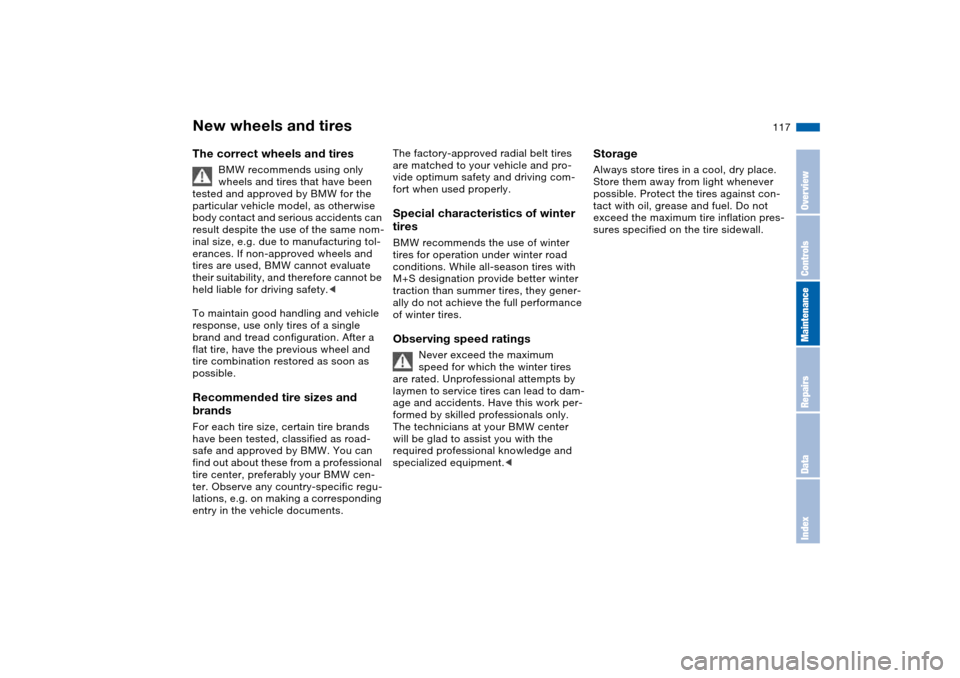2006 BMW M3 COUPE tire size
[x] Cancel search: tire sizePage 112 of 170

112Wheels and tires
Tire inflation pressureInformation for your safetyIt is not merely the tire's service life, but
also driving comfort and, above all else,
driving safety that depend on the condi-
tion of the tires and the maintenance of
the specified tire pressure.Checking tire pressuresOnly check the tire inflation pressures
of cold tires. This means after driving a
maximum of 1.25 miles/2 km or after
the vehicle has been parked for at least
2 hours. Warm tires have higher infla-
tion pressures.
Check tire inflation pressures reg-
ularly and correct them if neces-
sary: at least twice a month and before
beginning a longer trip. Otherwise,
incorrect tire pressures can cause driv-
ing instability or tire damage, ultimately
resulting in accidents. Do not drive on a
deflated, i.e. flat, tire. A flat tire greatly
impairs steering and braking response,
and can lead to complete loss of con-
trol over the vehicle.<
After correcting the tire inflation pres-
sure, reinitialize the Flat Tire Monitor,
refer to page 84.
Inflation pressures for original
tiresTire pressures for the standard tires of
your vehicle are shown on the driver's
door post, visible when the door is
open.
The inflation pressures apply to BMW-
approved tire sizes and recommended
tire brands. Your BMW center will be
glad to supply this information.Inflation pressures for other tire
sizesThe following tire pressure table shows
all tire pressures for the given tire sizes
at ambient temperature.
Page 114 of 170

114
Tire codeKnowing the tire code on the tire side-
wall makes it easier to correctly choose
and identify your tires.Tire sizeE.g. 205/60 R 15 91 W
205 = Nominal width in mm
60 = Cross-sectional ratio in %
R = Radial belt construction
15 = Rim diameter in inches
91 = Load index, not on ZR tires
W = Speed rating, in front of the R on
ZR tiresSpeed ratingQ = up to 100 mph (160 km/h)
T = up to 118 mph (190 km/h)
H = up to 130 mph (210 km/h)
V = up to 150 mph (240 km/h)
W = up to 167 mph (270 km/h)
Y = up to 186 mph (300 km/h)Tire Identification NumberTires with DOT codes comply with the
guidelines of the U.S. Department of
Transportation.DOT code:
E.g. DOT xxxx xxx 3204
xxxx = Manufacturer's code for tire
brand
xxx = Tire size and tire version
3204 = Tire age
Tire ageThe date on which the tire was manu-
factured is indicated by the code on the
sidewall:
DOT … 3204 indicates that the tire was
manufactured in week 32 of the year
2004.
BMW recommends the replacement of
all tires when they are no more than
6 years old, even if a tire life of 10 years
is possible.Uniform Tire Quality GradingQuality grades can be found where
applicable on the tire sidewall between
tread shoulder and maximum section
width. For example:
Tread wear 200 Traction AA
Temperature ADOT quality gradesTread wearTraction AA A B C
Temperature A B C
All passenger car tires must con-
form to Federal Safety Require-
ments in addition to these grades.<
Tread wearThe tread wear grade is a comparative
rating based on the wear rate of the tire
when tested under controlled condi-
tions on a specified government test
course.
For example, a tire graded 150 would
wear one and one-half – 1
1/2 – times as
well on the government course as a tire
graded 100. The relative performance
of tires depends upon the actual condi-
tions of their use, however, and may
depart significantly from the norm due
to variations in driving habits, service
practices and differences in road char-
acteristics and climate.
TractionThe traction grades, from highest to
lowest, are AA, A, B, and C.
Page 117 of 170

117
The correct wheels and tires
BMW recommends using only
wheels and tires that have been
tested and approved by BMW for the
particular vehicle model, as otherwise
body contact and serious accidents can
result despite the use of the same nom-
inal size, e.g. due to manufacturing tol-
erances. If non-approved wheels and
tires are used, BMW cannot evaluate
their suitability, and therefore cannot be
held liable for driving safety.<
To maintain good handling and vehicle
response, use only tires of a single
brand and tread configuration. After a
flat tire, have the previous wheel and
tire combination restored as soon as
possible.
Recommended tire sizes and
brandsFor each tire size, certain tire brands
have been tested, classified as road-
safe and approved by BMW. You can
find out about these from a professional
tire center, preferably your BMW cen-
ter. Observe any country-specific regu-
lations, e.g. on making a corresponding
entry in the vehicle documents.
The factory-approved radial belt tires
are matched to your vehicle and pro-
vide optimum safety and driving com-
fort when used properly.Special characteristics of winter
tiresBMW recommends the use of winter
tires for operation under winter road
conditions. While all-season tires with
M+S designation provide better winter
traction than summer tires, they gener-
ally do not achieve the full performance
of winter tires.Observing speed ratings
Never exceed the maximum
speed for which the winter tires
are rated. Unprofessional attempts by
laymen to service tires can lead to dam-
age and accidents. Have this work per-
formed by skilled professionals only.
The technicians at your BMW center
will be glad to assist you with the
required professional knowledge and
specialized equipment.<
StorageAlways store tires in a cool, dry place.
Store them away from light whenever
possible. Protect the tires against con-
tact with oil, grease and fuel. Do not
exceed the maximum tire inflation pres-
sures specified on the tire sidewall.
New wheels and tires
OverviewControlsMaintenanceRepairsDataIndex
Page 164 of 170

Everything from A to ZService and Warranty Infor-
mation Booklet 126
Service Engine Soon
warning lamp 19
Service interval display
77, 126
Shift lights 70
Shift paddles 67
Side airbags 52
Side turn signal indicators
bulb replacement 134
Size 151
Ski bag 101
Sliding/tilt sunroof, refer to
Electric glass sunroof 40
SMG Drivelogic 66
Smokers' package, refer to
Ashtray 98
Snow chains 118
SOS, refer to Emergency
call 142
Spare key 28, 29
Special oils 123
Special oils, refer to Speci-
fied engine oils 123
Specified engine oils 123
Speed gauge, refer to
Speedometer 16
Speedometer 16
Sport mode 85
Sports seat 44Stability control, refer to
Dynamic Stability Control
(DSC) 82
Stability control, refer to M
Track mode 82
Standing lamps 88
bulb replacement 133
Starting difficulties
jump-starting 143
temperature 62
Starting the engine 62
Starting, refer to Starting the
engine 62
Starting-off assistance
DSC 82
gradient assistance 69
Status of the Owner's Man-
ual 5
Steering wheel lock 61
Steering wheel, adjusting 51
Storage compartments 96
Storage nets 96
Storing seat positions,
refer to Seat and mirror
memory 48
Storing tires 117
Stroke, refer to Engine
data 150
Sun blind 94
Sun blind, refer to Roller sun
blind 94Surface ice, refer to Ice
warning 79
Switches, refer to
Cockpit 14
Switching off
engine 64
Symbols 4
T
Tachometer 75
Tail lamps
bulb replacement 135
Tail lamps, refer to Rear
lamps 135
Tank capacity, refer to Fuel
tank capacity 153
Tank indicator, refer to Fuel
gauge 76
Technical data 150
Technical modifications 6
Technical modifications,
refer to For your own
safety 6
Telephone hookup
microphone 97
Telephone, refer to the sep-
arate Owner's Manual
Television, refer to the
Owner's Manual for
Onboard ComputerTemperature
automatic climate
control 92
Temperature adjustment 92
Temperature display
engine coolant 76
outside temperature 79
setting units 79
Temperature layering 93
Tempomat, refer to Cruise
control 73
Thigh support area, adjust-
ing 44
Third brake lamp, refer to
Center high-mount brake
lamp 136
Threaded socket for towing
eyelet 145
Three-point safety belt 46
Through-loading system 100
Tilt alarm sensor 30, 38
remote control 30
switching off 30, 38
Tilting passenger-side exte-
rior mirror 49
Time 78
Tire inflation pressure 112
Tire pressure monitoring,
refer to Flat Tire
Monitor 83